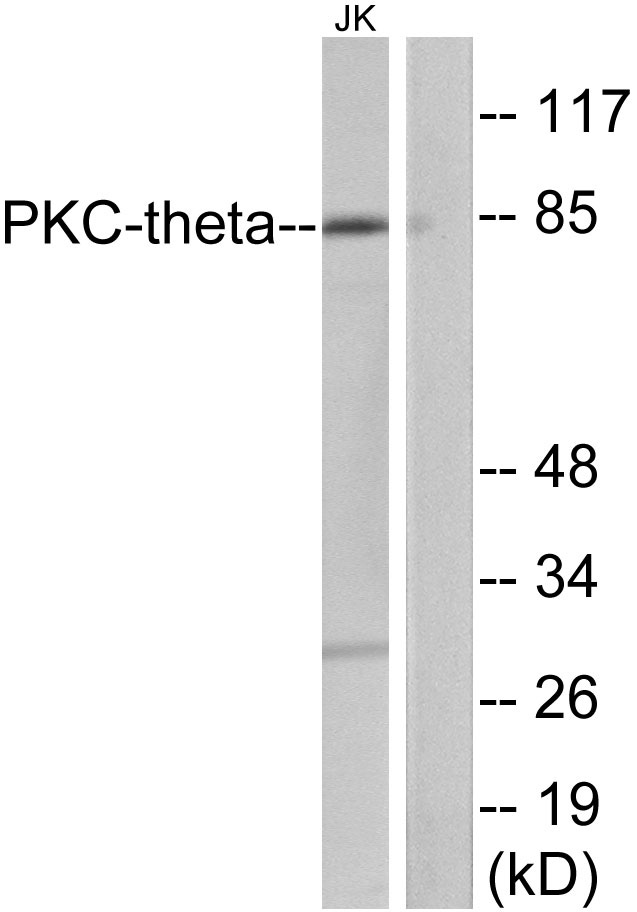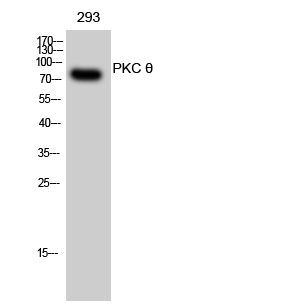PKC θ Polyclonal Antibody
- Catalog No.:YT3768
- Applications:WB;IHC;IF;ELISA
- Reactivity:Human;Mouse;Rat
- Target:
- PKC θ
- Fields:
- >>NF-kappa B signaling pathway;>>Autophagy - animal;>>Vascular smooth muscle contraction;>>Th1 and Th2 cell differentiation;>>Th17 cell differentiation;>>T cell receptor signaling pathway;>>Inflammatory mediator regulation of TRP channels;>>Adipocytokine signaling pathway;>>Insulin resistance;>>Shigellosis;>>PD-L1 expression and PD-1 checkpoint pathway in cancer
- Gene Name:
- PRKCQ
- Protein Name:
- Protein kinase C theta type
- Human Gene Id:
- 5588
- Human Swiss Prot No:
- Q04759
- Mouse Gene Id:
- 18761
- Mouse Swiss Prot No:
- Q02111
- Rat Swiss Prot No:
- Q9WTQ0
- Immunogen:
- The antiserum was produced against synthesized peptide derived from human PKC thet. AA range:643-692
- Specificity:
- PKC θ Polyclonal Antibody detects endogenous levels of PKC θ protein.
- Formulation:
- Liquid in PBS containing 50% glycerol, 0.5% BSA and 0.02% sodium azide.
- Source:
- Polyclonal, Rabbit,IgG
- Dilution:
- WB 1:500 - 1:2000. IHC 1:100 - 1:300. IF 1:200 - 1:1000. ELISA: 1:20000. Not yet tested in other applications.
- Purification:
- The antibody was affinity-purified from rabbit antiserum by affinity-chromatography using epitope-specific immunogen.
- Concentration:
- 1 mg/ml
- Storage Stability:
- -15°C to -25°C/1 year(Do not lower than -25°C)
- Other Name:
- PRKCQ;PRKCT;Protein kinase C theta type;nPKC-theta
- Observed Band(KD):
- 82kD
- Background:
- Protein kinase C (PKC) is a family of serine- and threonine-specific protein kinases that can be activated by calcium and the second messenger diacylglycerol. PKC family members phosphorylate a wide variety of protein targets and are known to be involved in diverse cellular signaling pathways. PKC family members also serve as major receptors for phorbol esters, a class of tumor promoters. Each member of the PKC family has a specific expression profile and is believed to play a distinct role. The protein encoded by this gene is one of the PKC family members. It is a calcium-independent and phospholipid-dependent protein kinase. This kinase is important for T-cell activation. It is required for the activation of the transcription factors NF-kappaB and AP-1, and may link the T cell receptor (TCR) signaling complex to the activation of the transcription factors. [provided by RefSeq, Jul 2008],
- Function:
- catalytic activity:ATP + a protein = ADP + a phosphoprotein.,cofactor:Magnesium.,domain:The C1 domain, containing the phorbol ester/DAG-type region 1 (C1A) and 2 (C1B), is the diacylglycerol sensor and the C2 domain is a non-calcium binding domain.,enzyme regulation:Three specific sites; Thr-538 (activation loop of the kinase domain), Ser-676 (turn motif) and Ser-695 (hydrophobic region), need to be phosphorylated for its full activation.,function:PKC is activated by diacylglycerol which in turn phosphorylates a range of cellular proteins. PKC also serves as the receptor for phorbol esters, a class of tumor promoters.,function:This is a calcium-independent, phospholipid-dependent, serine- and threonine-specific enzyme. Essential for T-cell receptor (TCR)-mediated T-cell activation, but is dispensable during TCR-dependent thymocyte development. Links the TCR signaling complex to the activ
- Subcellular Location:
- Cytoplasm. Cell membrane; Peripheral membrane protein. In resting T-cells, mostly localized in cytoplasm. In response to TCR stimulation, associates with lipid rafts and then localizes in the immunological synapse.
- Expression:
- Expressed in skeletal muscle, T-cells, megakaryoblastic cells and platelets.
- June 19-2018
- WESTERN IMMUNOBLOTTING PROTOCOL
- June 19-2018
- IMMUNOHISTOCHEMISTRY-PARAFFIN PROTOCOL
- June 19-2018
- IMMUNOFLUORESCENCE PROTOCOL
- September 08-2020
- FLOW-CYTOMEYRT-PROTOCOL
- May 20-2022
- Cell-Based ELISA│解您多样本WB检测之困扰
- July 13-2018
- CELL-BASED-ELISA-PROTOCOL-FOR-ACETYL-PROTEIN
- July 13-2018
- CELL-BASED-ELISA-PROTOCOL-FOR-PHOSPHO-PROTEIN
- July 13-2018
- Antibody-FAQs
- Products Images

- Western blot analysis of lysates from Jurkat cells, treated with PMA 200nM 30', using PKC thet Antibody. The lane on the right is blocked with the synthesized peptide.


